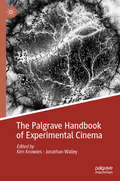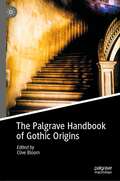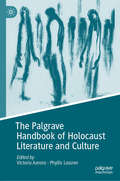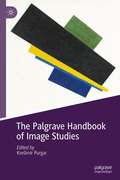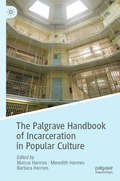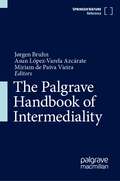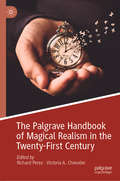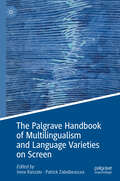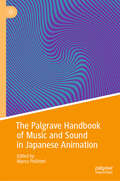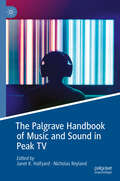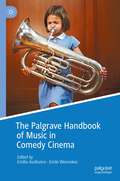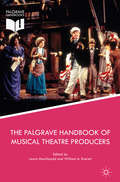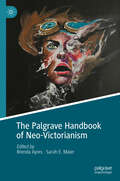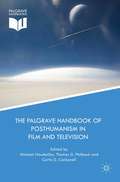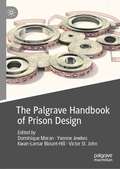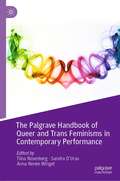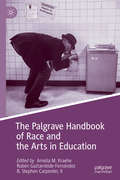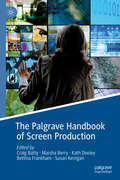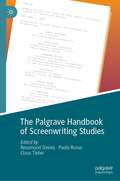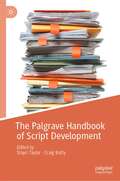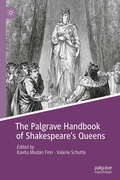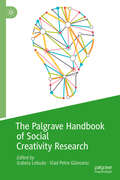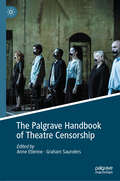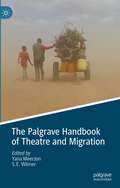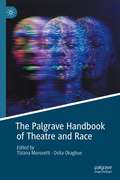- Table View
- List View
The Palgrave Handbook of Experimental Cinema
by Kim Knowles Jonathan WalleyThis book is a collection of newly commissioned essays by established and emerging scholars that maps out the current landscape of experimental cinema studies and sets agendas for future work in the field. Introducing new critical methodologies and calling overdue attention to neglected artists, regions, and topics, the contributions to this volume reassess and reassert experimental cinema as a site of formal exploration and interrogation as well as resistance to institutional, political, and social norms. This collection articulates what it means for experimental cinema to be these things in the contemporary moment, staking out new directions in thinking about the subject not only as a growing sub-field of cinema studies, but as an artistic and scholarly tradition in dialogue with art history, visual culture, philosophy, and the sciences. The contributions reflect a diversity of voices and perspectives, weaving together theoretical, poetic, and personal modes of writing and traversing questions of form, emotion, materiality, nationality, postcoloniality, the body, and ecology.
The Palgrave Handbook of Gothic Origins
by Clive BloomThis handbook provides a comprehensive overview of research on the Gothic Revival. The Gothic Revival was based on emotion rather than reason and when Horace Walpole created Strawberry Hill House, a gleaming white castle on the banks of the Thames, he had to create new words to describe the experience of gothic lifestyle. Nevertheless, Walpole’s house produced nightmares and his book The Castle of Otranto was the first truly gothic novel, with supernatural, sensational and Shakespearean elements challenging the emergent fiction of social relationships. The novel’s themes of violence, tragedy, death, imprisonment, castle battlements, dungeons, fair maidens, secrets, ghosts and prophecies led to a new genre encompassing prose, theatre, poetry and painting, whilst opening up a whole world of imagination for entrepreneurial female writers such as Mary Shelley, Joanna Baillie and Ann Radcliffe, whose immensely popular books led to the intense inner landscapes of the Bronte sisters. Matthew Lewis’s The Monk created a new gothic: atheistic, decadent, perverse, necrophilic and hellish. The social upheaval of the French Revolution and the emergence of the Romantic movement with its more intense (and often) atheistic self-absorption led the gothic into darker corners of human experience with a greater emphasis on the inner life, hallucination, delusion, drug addiction, mental instability, perversion and death and the emerging science of psychology. The intensity of the German experience led to an emphasis on doubles and schizophrenic behaviour, ghosts, spirits, mesmerism, the occult and hell. This volume charts the origins of this major shift in social perceptions and completes a trilogy of Palgrave Handbooks on the Gothic—combined they provide an exhaustive survey of current research in Gothic studies, a go-to for students and researchers alike.
The Palgrave Handbook of Holocaust Literature and Culture
by Victoria Aarons Phyllis LassnerThe Palgrave Handbook of Holocaust Literature and Culture reflects current approaches to Holocaust literature that open up future thinking on Holocaust representation. The chapters consider diverse generational perspectives—survivor writing, second and third generation—and genres—memoirs, poetry, novels, graphic narratives, films, video-testimonies, and other forms of literary and cultural expression. In turn, these perspectives create interactions among generations, genres, temporalities, and cultural contexts. The volume also participates in the ongoing project of responding to and talking through moments of rupture and incompletion that represent an opportunity to contribute to the making of meaning through the continuation of narratives of the past. As such, the chapters in this volume pose options for reading Holocaust texts, offering openings for further discussion and exploration. The inquiring body of interpretive scholarship responding to the Shoah becomes itself a story, a narrative that materially extends our inquiry into that history.
The Palgrave Handbook of Image Studies
by Krešimir PurgarThis handbook brings together the most current and hotly debated topics in studies about images today. In the first part, the book gives readers an historical overview and basic diacronical explanation of the term image, including the ways it has been used in different periods throughout history. In the second part, the fundamental concepts that have to be mastered should one wish to enter into the emerging field of Image Studies are explained. In the third part, readers will find analysis of the most common subjects and topics pertaining to images. In the fourth part, the book explains how existing disciplines relate to Image Studies and how this new scholarly field may be constructed using both old and new approaches and insights. The fifth chapter is dedicated to contemporary thinkers and is the first time that theses of the most prominent scholars of Image Studies are critically analyzed and presented in one place.
The Palgrave Handbook of Incarceration in Popular Culture
by Marcus Harmes Meredith Harmes Barbara HarmesThe Handbook of Incarceration in Popular Culture will be an essential reference point, providing international coverage and thematic richness. The chapters examine the real and imagined spaces of the prison and, perhaps more importantly, dwell in the uncertain space between them. The modern fixation with ‘seeing inside’ prison from the outside has prompted a proliferation of media visions of incarceration, from high-minded and worthy to voyeuristic and unrealistic. In this handbook, the editors bring together a huge breadth of disparate issues including women in prison, the view from ‘inside’, prisons as a source of entertainment, the real worlds of prison, and issues of race and gender. The handbook will inform students and lecturers of media, film, popular culture, gender, and cultural studies, as well as scholars of criminology and justice.
The Palgrave Handbook of Intermediality
by Jørgen Bruhn Asun López-Varela Azcárate Miriam de Paiva VieiraThis handbook provides an extensive overview of traditional and emerging research areas within the field of intermediality studies, understood broadly as the study of interrelations among all forms of communicative media types, including transmedial phenomena. Section I offers accounts of the development of the field of intermediality - its histories, theories and methods. Section II and III then explore intermedial facets of communication from ancient times until the 21st century, with discussion on a wide range of cultural and geographical settings, media types, and topics, by contributors from a diverse set of disciplines. It concludes in Section IV with an emphasis on urgent societal issues that an intermedial perspective might help understand.
The Palgrave Handbook of Magical Realism in the Twenty-First Century
by Richard Perez Victoria A. ChevalierThe Palgrave Handbook of Magical Realism in the Twenty-First Century examines magical realism in literatures from around the globe. Featuring twenty-seven essays written by leading scholars, this anthology argues that literary expressions of magical realism proliferate globally in the twenty-first century due to travel and migrations, the shrinking of time and space, and the growing encroachment of human life on nature. In this global context, magical realism addresses twenty-first-century politics, aesthetics, identity, and social/national formations where contact between and within cultures has exponentially increased, altering how communities and nations imagine themselves. This text assembles a group of critics throughout the world—the Americas, Europe, Africa, Asia, the Middle East, and Australia—who employ multiple theoretical approaches to examine the different ways magical realism in literature has transitioned to a global practice; thus, signaling a new stage in the history and development of the genre.
The Palgrave Handbook of Multilingualism and Language Varieties on Screen
by Irene Ranzato Patrick ZabalbeascoaThis handbook brings together contributions from the main experts in the field of multilingualism and language varieties (including dialects, accents, sociolects, and idiolects of specific speech communities) as expressed in fictional dialogue on-screen in films, and television series. The chapters included in the volume cover both the representation of these varieties and multilingual situations on screen as well as their translation into a range of languages. The handbook will thus be an essential resource for scholars and students in diverse fields including translation studies, audiovisual translation, linguistics, dialectology, film and television studies.
The Palgrave Handbook of Music and Sound in Japanese Animation (Palgrave Studies in Sound)
by Marco PellitteriThis handbook fills a substantial gap in the international academic literature on animation at large, on music studies, and on the aural dimensions of Japanese animation more specifically. It offers a unique contribution at the intersection between music and popular culture studies on the one hand, and research on Japanese animated productions (often called ‘anime’) as popular art forms and formats of entertainment, on the other. The book is designed as a reference work consisting of an organic sequence of theory-grounded essays on the development of music, sounds, and voices in Japanese animation for cinema and television since the 1930s. Each chapter deals with a phase of this history, focusing on composers and performers, films, series, and genres used in the soundtracks for animations made in Japan. The chapters also offer valuable interviews with prominent figures of music in Japanese animation, as well as chapter boxes clarifying specific aspects.
The Palgrave Handbook of Music and Sound in Peak TV
by Janet K. Halfyard Nicholas ReylandThe Palgrave Handbook to Music and Sound in Peak TV charts the transformation of television’s sonic storytelling during the new “golden age” of televisual narrative from the late 1990s to the early 2020s. Grounded in close analytical, critical, and theoretical work identifying the key traits of music and sound in this “peak TV” period, the book casts its critical net wider to develop interpretations of significance not just for screen music studies and musicology, but for screen and media studies too. By theorizing “peakness” with respect to sound and music, and by drawing together contributions from a diverse collection of prominent musicologists, media scholars, and practitioners, this handbook provides the authoritative guide to the role music has played in creating the success of some of the most culturally and commercially significant popular art of the early twenty-first century. The volume contains 25 essays in three main sections—Concepts and Aesthetics, Practices and Production, and Audiences and Interpretations. Topics discussed include peakness, complexity, ostentatious scoring, antiheroes, memory, franchises, worldbuilding, nostalgia, maternity, trauma, actor’s voices, title sequences, library music, branding, queer/camp scoring, kids TV, captioning, industry practices, HBO, and sound design. Shows examined include The Sopranos, The Wire, Game of Thrones, Battlestar Galactica, Westworld, Buffy the Vampire Slayer, Stranger Things, The Bridge, Dexter, Killing Eve, Mad Men, American Horror Story, Rings of Power, Fargo, Peaky Blinders, Call the Midwife, Twin Peaks, and Twin Peaks: The Return.
The Palgrave Handbook of Music in Comedy Cinema
by Emilio Audissino Emile WennekesThis handbook tackles the understudied relationship between music and comedy cinema by analysing the nature, perception, and function of music from fresh perspectives. Its approach is not only multidisciplinary, but also interdisciplinary in its close examination of how music and other cinematic devices interact in the creation of comedy. The volume addresses gender representation, national identities, stylistic strategies, and employs inputs from cultural studies, musicology, music theory, psychology, cognitivism, semiotics, formal and stylistic film analysis, and psychoanalysis. It is organised in four sections: general introductions, theoretical investigations, music and comedy within national cinemas, and exemplary case studies of films or authors.
The Palgrave Handbook of Musical Theatre Producers
by William A. Everett Laura MacdonaldThis handbook is the first to provide a systematic investigation of the various roles of producers in commercial and not-for-profit musical theatre. Featuring fifty-one essays written by international specialists in the field, it offers new insights into the world of musical theatre, its creation and its promotion. Key areas of investigation include the lives and works of producers whose work is part of a US and worldwide musical theatre legacy, as well as the largely critically-neglected role of the musical theatre producer in the making, marketing, and performance of musicals. Also explored are the shifting roles of producers in musical theatre and their popular portrayals, offering a reader-friendly collection for fans, scholars, students, and practitioners of musical theatre alike.
The Palgrave Handbook of Neo-Victorianism
by Brenda Ayres Sarah E. MaierThis handbook offers analysis of diverse genres and media of neo-Victorianism, including film and television adaptations of Victorian texts, authors’ life stories, graphic novels, and contemporary fiction set in the nineteenth century. Contextualized by Sarah E Maier and Brenda Ayres in a comprehensive introduction, the collection describes current trends in neo-Victorian scholarship of novels, film, theatre, crime, empire/postcolonialism, Gothic, materiality, religion and science, amongst others. A variety of scholars from around the world contribute to this volume by applying an assortment of theoretical approaches and interdisciplinary focus in their critique of a wide range of narratives—from early neo-Victorian texts such as A. S. Byatt’s Possession (1963) and Jean Rhys’ Wide Sargasso Sea (1966) to recent steampunk, from musical theatre to slumming, and from The Alienist to queerness—in their investigation of how this fiction reconstructs the past, informed by and reinforming the present.
The Palgrave Handbook of Posthumanism in Film and Television
by Michael Hauskeller Thomas D. Philbeck Curtis D. CarbonellWhat does popular culture's relationship with cyborgs, robots, vampires and zombies tell us about being human? Insightful scholarly perspectives shine a light on how film and television evince and portray the philosophical roots, the social ramifications and the future visions of a posthumanist world.
The Palgrave Handbook of Prison Design (Palgrave Studies in Prisons and Penology)
by Yvonne Jewkes Dominique Moran Kwan-Lamar Blount-Hill Victor St. JohnThis handbook brings together expertise from a range of disciplinary perspectives and geographical contexts to address a key question facing prison policymakers, architects and designers – what kind of carceral environments foster wellbeing, i.e. deliver a rehabilitative, therapeutic environment, or other ‘positive’ outcomes? The Palgrave Handbook of Prison Design offers insights into the construction of custodial facilities, alongside consideration of the critical questions any policymaker should ask in commissioning the building of a site for human containment. Chapters present experience from Australia, Chile, Estonia, Ireland, New Zealand, Norway, Russia, the United Kingdom, and the United States – jurisdictions which vary widely in terms of the history and development of their prison systems, their punitive philosophies, and the nature of their public discourse about the role and purpose of imprisonment, to offer readers theories, frameworks, historical accounts, design approaches, methodological strategies, empirical research, and practical approaches.
The Palgrave Handbook of Queer and Trans Feminisms in Contemporary Performance
by Tiina Rosenberg Sandra D’Urso Anna Renée WingetThe purpose of this Handbook is to provide students with an overview of key developments in queer and trans feminist theories and their significance to the field of contemporary performance studies. It presents new insights highlighting the ways in which rigid or punishing notions of gender, sexuality and race continue to flourish in systems of knowledge, faith and power which are relevant to a new generation of queer and trans feminist performers today.The guiding question for the Handbook is: How do queer and trans feminist theories enhance our understanding of developments in feminist performance today, and will this discussion give rise to new ways of theorizing contemporary performance? As such, the volume will survey a new generation of performers and theorists, as well as senior scholars, who engage and redefine the limits of performance. The chapters will demonstrate how intersectional, queer and trans feminist theoretical tools support new analyses of performance with a global focus. The primary audience will be students of theatre/ performance studies as well as queer /gender studies. The volume’s contents suggest close links between the formation of queer feminist identities alongside recent key political developments with transnational resonances. Furthermore, the emergence of new queer and trans feminist epistemologies prompts a reorientation regarding performance and identities in a 21st-century context.
The Palgrave Handbook of Race and the Arts in Education
by Amelia M. Kraehe Rubén Gaztambide-Fernández B. Stephen Carpenter IIThe Palgrave Handbook of Race and the Arts in Education is the first edited volume to examine how race operates in and through the arts in education. Until now, no single source has brought together such an expansive and interdisciplinary collection in exploration of the ways in which music, visual art, theater, dance, and popular culture intertwine with racist ideologies and race-making. Drawing on Critical Race Theory, contributing authors bring an international perspective to questions of racism and anti-racist interventions in the arts in education. The book’s introduction provides a guiding framework for understanding the arts as white property in schools, museums, and informal education spaces. Each section is organized thematically around historical, discursive, empirical, and personal dimensions of the arts in education. This handbook is essential reading for students, educators, artists, and researchers across the fields of visual and performing arts education, educational foundations, multicultural education, and curriculum and instruction.
The Palgrave Handbook of Screen Production
by Craig Batty Marsha Berry Susan Kerrigan Kath Dooley Bettina FrankhamThis handbook is an essential creative, critical and practical guide for students and educators of screen production internationally. It covers all aspects of screen production—from conceptualizing ideas and developing them, to realizing and then distributing them—across all forms and formats, including fiction and non-fiction for cinema, television, gallery spaces and the web. With chapters by practitioners, scholars and educators from around the world, the book provides a comprehensive collection of approaches for those studying and teaching the development and production of screen content. With college and university students in mind, the volume purposely combines theory and practice to offer a critically informed and intellectually rich guide to screen production, shaped by the needs of those working in education environments where ‘doing’ and ‘thinking’ must co-exist. The Palgrave Handbook of Screen Production fills an important gap in creative-critical knowledge of screen production, while also providing practical tools and approaches for future practitioners.
The Palgrave Handbook of Screenwriting Studies
by Rosamund Davies Claus Tieber Paolo RussoThis book provides an overview of the growing field of screenwriting research and is essential reading for both those new to the field and established screenwriting scholars. It covers topics and concepts central to the study of screenwriting and the screenplay in relation to film, television, web series, animation, games and other interactive media, and includes a range of approaches, from theoretical perspectives to in-depth case studies. 44 scholars from around the globe demonstrate the range and depths of this new and expanding area of study. As the chapters of this Handbook demonstrate, shifting the focus from the finished film to the process of screenwriting and the text of the screenplay facilitates valuable new insights. This Handbook is the first of its kind, an indispensable compendium for both academics and practitioners.
The Palgrave Handbook of Script Development
by Craig Batty Stayci TaylorThe Palgrave Handbook of Script Development provides the first comprehensive overview of international script development practices. Across 40 unique chapters, readers are guided through the key challenges, roles and cultures of script development, from the perspectives of creators of original works, those in consultative roles and those giving broader contextual case studies. The authors take us inside the writers’ room, alongside the script editor, between development conversations, and outside the mainstream and into the experimental. With authors spanning upwards of 15 countries, and occupying an array of roles – including writer, script editor, producer, script consultant, executive, teacher and scholar, this is a truly international perspective on how script development functions (or otherwise) across media and platforms. Comprising four parts, the handbook guides readers behind the scenes of script development, exploring unique contexts, alternative approaches, specific production cultures and global contexts, drawing on interviews, archives, policy, case study research and the insider track. With its broad approach to a specialised practice, the Palgrave Handbook of Script Development is for anyone who practices, teaches or studies screenwriting and screen production.
The Palgrave Handbook of Shakespeare's Queens (Queenship and Power)
by Valerie Schutte Kavita Mudan FinnOf Shakespeare’s thirty-seven plays, fifteen include queens. This collection gives these characters their due as powerful early modern women and agents of change, bringing together new perspectives from scholars of literature, history, theater, and the fine arts. Essays span Shakespeare’s career and cover a range of famous and lesser-known queens, from the furious Margaret of Anjou in the Henry VI plays to the quietly powerful Hermione in The Winter’s Tale; from vengeful Tamora in Titus Andronicus to Lady Macbeth. Early chapters situate readers in the critical concerns underpinning any discussion of Shakespeare and queenship: the ambiguous figure of Elizabeth I, and the knotty issue of gender presentation. The focus then moves to analysis of issues such as motherhood, intertextuality, and contemporary political contexts; close readings of individual plays; and investigations of rhetoric and theatricality. Featuring twenty-five chapters with a rich variety of themes and methodologies, this handbook is an invaluable reference for students and scholars, and a unique addition to the fields of Shakespeare and queenship studies.
The Palgrave Handbook of Social Creativity Research (Palgrave Studies in Creativity and Culture)
by Vlad Petre Glăveanu Izabela LebudaThis Handbook brings together an international cast of experts to explore the social nature and context of creativity studies, focusing on methodology as a key component in advancing the social study of creativity. Two decades on from the pioneering work of Alfonso Montuori and Ronald E. Purser, the authors present a timely appraisal of past and present work in social creativity studies, and look ahead to future developments within this field. The authors collectively offer a rigorous examination of the methodological and empirical issues and techniques involved in studying social creativity. They examine the phenomenon as a form of communication and interaction within collaborative relationships; contending that creativity happens not within a vacuum but instead from a nexus of personal, social and contextual influences.This comprehensive work is organized in three parts, focusing first on the various methodological approaches applicable to the social in creativity studies. It secondly turns to empirical findings and approaches relating to the social nature of creativity. In the book’s final part, the authors offer reflections on the state of social research into creativity, pinpointing areas requiring further methodological scrutiny and empirical verification, and areas that may inspire further theoretical or applied work. Combining classic ideas with cutting-edge, emerging methods, this work provides a vital methodological ‘toolbox’ for investigators within social creativity.
The Palgrave Handbook of Theatre Censorship
by Graham Saunders Anne EtienneThis book incorporates a wide theoretical, cultural, literary and historical engagement in exploring the tension between dramatic productions and the forms of censorship they encounter from creation to reception. The Palgrave Handbook of Theatre Censorship offers global new insights into censorship practices, examining attempts at repression motivated either by fears that audiences gathering together to watch live dramatic events will lead to sedition and mass uprisings, or by moral or religious squeamishness requiring the establishment of institutional systems of censorship to curb or suppress the stage. As such, the Handbook aims to initiate redefinitions of what we understand or experience as censorship. Who knew theatre could (still) carry so many threats, or be so widely provocative and dangerous? This is an extraordinary and often eye-opening set of thirty-six individually insightful, wide-ranging and oftentimes disturbing essays, each of which offers unique insights into theatre censorship practices and their impact within a specific political and moral culture. There is a particular emphasis on the recent and current, and the authors speak with first-hand knowledge and from direct experience not only about the restrictions but also how artists sometimes negotiate and evade these. What makes the book so especially fascinating and illuminating is seeing so many examples juxtaposed together. This enables the reader to hear the essays and the cultures talking to and alongside each other. The collection repeatedly breaks fresh ground, and the editors deserve enormous credit for gathering and effectively curating so many reports from the front-line. Steve Nicholson, Emeritus Professor, University of Sheffield, UK Anne Etienne and Graham Saunders’s book is a wide-ranging, incisive and compelling collection of reflections and case studies on the theatre industry’s relationship to censorship and self-censorship from a historical and contemporaneous perspective. An impressive array of authors have been assembled for this volume representing, among them, views on the subject from Spain, Denmark, Norway, Zimbabwe, South Africa, Germany, Italy, Indonesia, Iran, Portugal, Turkey, Brazil, Japan, Ireland, Australia, Russia, England and more. The book is by turns surprising in its curatorial and narrative design and wonderfully effective at delineating the complex and thorny paths that create socio-political cultures where the censorship and self-censorship of theatre artists thrives and/or is efficaciously contested and rebelled against. Of note is a through line of argument in the book around less overt modes of surveillance that police artists’ imaginations and thereby the work they create and produce. At a time in the world where many governments are increasingly seeking to limit artistic expression, this book is a necessary reminder of the many freedoms that have been fought for in theatres around the globe, and how the power of being unsilenced must never be taken for granted. – Caridad Svich. Playwright & Translator This is a truly excellent collection of incisive studies. It is wide-ranging, impressively global in scope, with an illuminating balance of the historical and the contemporary. In its impressive and well-realised ambition, demonstrated by the well-focused intelligence and academic flair of its many contributors, this collection is both magisterial and vital. It is an essential contribution to censorship studies, fascinating and inspiring, a must-read for anyone interested in the subject. – Aleks Sierz. Theatre critic and author of Rewriting the Nation: British Theatre Today (2011) & Good Nights Out: A History of British Theatre Since the Second World War (2021)
The Palgrave Handbook of Theatre and Migration
by Yana Meerzon S. E. WilmerThe Palgrave Handbook of Theatre and Migration provides a wide survey of theatre and performance practices related to the experience of global movements, both in historical and contemporary contexts. Given the largest number of people ever (over one hundred million) suffering from forced displacement today, much of the book centres around the topic of refuge and exile and the role of theatre in addressing these issues. The book is structured in six sections, the first of which is dedicated to the major theoretical concepts related to the field of theatre and migration including exile, refuge, displacement, asylum seeking, colonialism, human rights, globalization, and nomadism. The subsequent sections are devoted to several dozen case studies across various geographies and time periods that highlight, describe and analyse different theatre practices related to migration. The volume serves as a prestigious reference work to help theatre practitioners, students, scholars, and educators navigate the complex field of theatre and migration.
The Palgrave Handbook of Theatre and Race
by Tiziana Morosetti Osita OkagbueThe first comprehensive publication on the subject, this book investigates interactions between racial thinking and the stage in the modern and contemporary world, with 25 essays on case studies that will shed light on areas previously neglected by criticism while providing fresh perspectives on already-investigated contexts. Examining performances from Europe, the Americas, the Middle East, Africa, China, Australia, New Zealand, and the South Pacifi c islands, this collection ultimately frames the history of racial narratives on stage in a global context, resetting understandings of race in public discourse.
